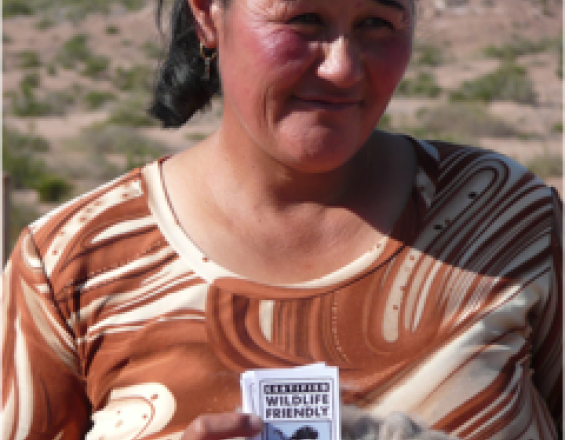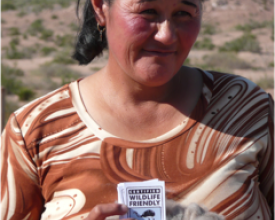
Certified Wildlife Friendly™ Agriculture

With over one-third of the planet’s land used for agriculture—and over one-quarter used for livestock grazing—farms and ranches offer both a great threat and a tremendous opportunity for wildlife conservation. Applying strategies to protect key species on agricultural lands is critical to the viability of wildlife populations, especially as open space diminishes and once-remote areas become accessible. By offering scientifically-sound, measurable standards to agricultural producers round the world, Certified Wildlife Friendly™ celebrates farm-level wildlife stewardship. Through this approach, the Wildlife Friendly Enterprise Network (WFEN) works to support both communities and wildlife alike by creating incentives for sound ecological management of farm and ranch lands around the world.
Context
Challenges addressed
Agricultural production poses many threats for global biodiversity with examples that include loss and fragmentation of critical habitat, land conversion and fencing, killing of predators that cause livestock losses, and chemical use. In many communities, a lack of economic opportunity results in hunting or poaching of wildlife as a means to survive. While best practices have been implemented in some places, these guidelines are not always accessible to farmers working in some of the most challenging places for human-wildlife conflict who may see solutions as too expensive to implement, even when available. However there is a growing community of producers who strive to minimize impacts on biodiversity and a growing consumer segment which gravitates to products that contribute to wildlife conservation. WFEN seeks to minimize barriers to entry for farmers making truly Wildlife Friendly™ products, and their respective markets, a reality.
Location
Process
Summary of the process
The criteria for certification must be tailored to the local context to ensure that communities are benefitting from the enterprise approach, to support building value in the conservation of biodiversity. Simultaneously, local stakeholders should be involved from the onset of the planning process, in the drafting of the standards, and in implementation of the criteria.
Building Blocks
Development of expert-driven standards for agriculture and biodiversity
The Wildlife Friendly Enterprise Network offers a range of certification programs that promote best practice standards for farming and ranching enterprises around the world. These standards represent global best practice with input from the appropriate experts to ensure that a) key species of wildlife are protected for net positive impact and b) local communities are actively involved.
Enabling factors
Local and policy contexts, market forces, and the threats to key species and needs of local communities are important factors in ensuring that certification is a viable solution where we work.
Lesson learned
The involvement of expert partners and local perspectives in the drafting of standards for our certification programs ensures that our criteria are relevant and beneficial in the contexts where we work, for the communities and key species involved.
Involvement of local communities in Wildlife Friendly™ enterprises
Enterprises are most successful when they leverage strong community involvement, collaborate with a local conservation organization, and are dedicated to the conservation of wildlife. Forming strong partnerships and avenues of communication on the ground ensures that certification benefits local communities and incentivizes the protection of biodiversity.
Enabling factors
Open avenues of communication, and the development of trust with all stakeholders, are critical in enabling the success of local partnerships and enterprise-based approaches.
Lesson learned
Forming partnerships early in the project planning process, and involving local partners in the early stages of implementation, helps to ensure local investment of the program itself and stewardship of the species that certification seeks to protect. These partnerships are most successful when communities and local groups see the value in certification and seek out external support themselves.
Impacts
Wildlife Friendly™ certification provides best practice guidelines for farming and ranching enterprises who seek to generate environmentally-sustainable employment and food security in some of the most critical biodiversity hotspots on the planet. The stories behind the products build consumer brand loyalty as well as open access to new markets, bringing benefits to local communities. Incentivizing best practices across the landscape works to ensure positive conservation outcomes and increased tolerance for wildlife. Wildlife Friendly™ farmers and ranchers possess a strong conservation ethic and many have been willing to change practices to achieve certification--enterprises have opted to prohibit trophy hunting, put in place monitoring programs, and provided new benefits for communities. Ibis Rice™ supports communities growing high-end rice, protecting critical wetlands in Cambodia, and gives a share of rice and profits to farming villages. New business enterprises are forming around the idea of Wildlife Friendly™ from inception, including recently-certified Elephant Friendly™ Tea, a collaboration with the University of Montana Broader Impacts Group, and Jaguar Friendly™ coffee, a collaboration between ProCAT, the Arizona Center for Nature Conservation/Phoenix Zoo and Press Coffee.
Beneficiaries
WFEN enterprises provide benefits to 270,000+ people worldwide through training, employment opportunities, improved education for children, and health care resulting from reinvestment of revenue.




